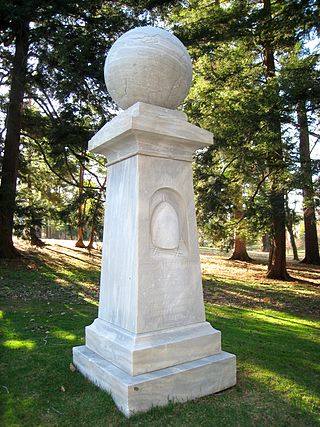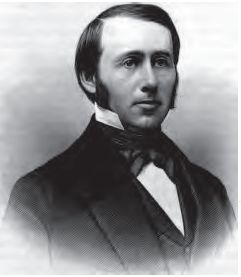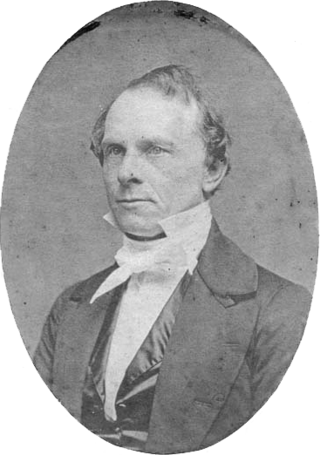Related Research Articles

Henry Ward Beecher was an American Congregationalist clergyman, social reformer, and speaker, known for his support of the abolition of slavery, his emphasis on God's love, and his 1875 adultery trial. His rhetorical focus on Christ's love has influenced mainstream Christianity through the 21st century.

Congregational churches are Protestant churches in the Reformed (Calvinist) tradition practicing congregationalist church governance, in which each congregation independently and autonomously runs its own affairs.

The Relief Society is a philanthropic and educational women's organization of the Church of Jesus Christ of Latter-day Saints. It was founded in 1842 in Nauvoo, Illinois, United States, and has more than 7 million members in over 188 countries and territories. The Relief Society is often referred to by the church and others as "one of the oldest and largest women's organizations in the world."

The American Board of Commissioners for Foreign Missions (ABCFM) was among the first American Christian missionary organizations. It was created in 1810 by recent graduates of Williams College. In the 19th century it was the largest and most important of American missionary organizations and consisted of participants from Protestant Reformed traditions such as Presbyterians, Congregationalists, and German Reformed churches.
The University of Olivet, formerly known as Olivet College, is a private Christian university in Olivet, Michigan. The college is accredited by the Higher Learning Commission. It was founded in 1844 by missionaries from Oberlin College, and it followed Oberlin in becoming the second coeducational college or university in the United States. The University of Olivet is affiliated with the United Church of Christ and the National Association of Congregational Christian Churches and stands in the Reformed tradition of Protestantism.

Charles William Penrose was a member of the Quorum of the Twelve Apostles of the Church of Jesus Christ of Latter-day Saints from 1904 to 1911. Penrose was also a member of the First Presidency, serving as a counselor to church presidents Joseph F. Smith and Heber J. Grant from 1911 until his death.

Heber Chase Kimball was a leader in the early Latter Day Saint movement. He served as one of the original twelve apostles in the early Church of the Latter Day Saints, and as first counselor to Brigham Young in the First Presidency of the Church of Jesus Christ of Latter-day Saints for more than two decades, from 1847 until his death.
The Congregational Christian Churches were a Protestant Christian denomination that operated in the U.S. from 1931 through 1957. On the latter date, most of its churches joined the Evangelical and Reformed Church in a merger to become the United Church of Christ. Others created the National Association of Congregational Christian Churches or joined the Conservative Congregational Christian Conference that formed earlier in 1945. During the forementioned period, its churches were organized nationally into a General Council, with parallel state conferences, sectional associations, and missionary instrumentalities. Congregations, however, retained their local autonomy and these groups were legally separate from the congregations.

George Albert Smith Sr. was an American religious leader who served as the eighth president of the Church of Jesus Christ of Latter-day Saints.

John Hamilton Morgan, was an early educator in Utah Territory, an official of the Church of Jesus Christ of Latter-day Saints, and a politician.
A mission of the Church of Jesus Christ of Latter-day Saints is a geographical administrative area to which church missionaries are assigned. Almost all areas of the world are within the boundaries of an LDS Church mission, whether or not any of the church's missionaries live or proselytize in the area. As of July 2020, there were 407 missions of the church.

Daniel Sylvester Tuttle was consecrated a bishop of the Episcopal Church in 1866. His first assignment was as Bishop of Montana, a missionary field that included Montana, Utah, and Idaho.

George Henry Atkinson was an American missionary and educator in what would become the state of Oregon. In Oregon, he served as a pastor for several churches, helped found what would become Pacific University, and pushed for legislation to create a public school system in Oregon Territory. The Massachusetts native later served as the county schools superintendent in Clackamas County and Multnomah counties.

Seymour Bicknell Young Sr. was a general authority of the Church of Jesus Christ of Latter-day Saints from 1882 until his death.

Warren Howard Hayes (1847–1899) was a leading designer of churches in the United States and Canada during the late 19th century. Hayes' work holds a significant place in its association with the "Social Gospel" movement. He is credited with some of the earliest use of the "diagonal auditorium" plan and the vast majority of his churches uncovered to date are centered on the diagonal auditorium design with fan shaped pew arrangements and, to assure excellent acoustics, the seating sloping toward the pulpit and domed ceilings. As noted at the opening of the Rockville Ct. Congregational Church:
The acoustic properties of the auditorium are something wonderful. The pastor says he never before spoke in church or hall which can compare with it in this respect. There are yet to be added a protected desk light for the pulpit and a shaded reflector for the organ. The seating capacity of the auditorium is 600, of the gallery 300, of the chapel 300. This capacity can be extended by placing chairs in vacant spaces without obstructing any aisles from 100 to 200 more. —Warren H. Hayes of Minneapolis.
Reuben Gaylord was the recognized leader of the missionary pioneers in the Nebraska Territory, and has been called the "father of Congregationalism in Nebraska." Writing in memory of Gaylord in the early 1900s, fellow Omaha pioneer George L. Miller said, "It was Reuben Gaylord, the brave Christian soldier who brought Sunday into Omaha and the Trans-Missouri country.
The First Congregational Church of Salt Lake City, Utah is a Congregational church affiliated with the National Association of Congregational Christian Churches. Established in 1865, it was the first church not a part of the Church of Jesus Christ of Latter-day Saints in Utah. The congregation started Utah's first free public schools.
The National Council of Congregational Churches of the United States was a mainline Protestant, Christian denomination in the United States. Its organization as a denomination was delayed by the Civil War. Congregational leaders met again in Boston, Massachusetts in 1865, where they began to hammer out standards of church procedures (polity) and adopted a statement of faith, known as the Burial Hill Declaration. Denominational organization came in 1871 with formation of the National Council of Congregational Churches, which existed until its merger in 1931. In 1928, there were 5,497 Congregational churches in the U.S. with a membership of 939,130. These churches were served by 5,648 ministers.

Richard Falley Cleveland was an American Congregationalist and Presbyterian minister. A graduate of Yale College and Princeton Theological Seminary, he spent most of his life as a pastor, outside of a brief period as a district secretary for the American Home Missionary Society. He is best known as the father of Grover Cleveland, who was twice President of the United States.

Congregationalism in the United States consists of Protestant churches in the Reformed tradition that have a congregational form of church government and trace their origins mainly to Puritan settlers of colonial New England. Congregational churches in other parts of the world are often related to these in the United States due to American missionary activities.
References
- ↑ The Home Missionary (The Home Missionary, Volumes 23-24 (June 1850) ed.). New York: Executive Committee of the American Home Missionary Society. 1851. pp. 25–32. Retrieved September 8, 2016.
the American Home Missionary Society held its Twenty Fourth Anniversary in the Broadway Tabernacle, New York on Wednesday evening, May 8th, 1850" + table on page 31 goes back to 1826 + page 32 says "at the organization of this Society in 1826
- ↑ The Home Missionary (The Home Missionary, Volumes 23-24 (June 1850) ed.). New York: Executive Committee of the American Home Missionary Society. 1851. pp. 25–32. Retrieved September 8, 2016.
"the missionaries of the United Domestic Missionary Society, whose responsibilities were transferred to it" ... "The New England State Societies, also, became integral parts of the National Society, in several successive years -- the Maine Missionary Society and the Vermont Domestic Missionary Society in the third year of its operations; the New Hampshire Missionary Society, in the fourth year; the Connecticut Missionary Society, in the fifth year; and the Massachusetts Missionary Society in the seventh year.
- 1 2 3 4 The New York State Register, for 1858. New York City: John Disturnell. 1858. p. 179 . Retrieved September 9, 2016.
N/A
- ↑ Horvath.
- ↑ The Home Missionary (The Home Missionary, Volumes 23-24 (June 1850) ed.). New York: Executive Committee of the American Home Missionary Society. 1851. p. 45 . Retrieved September 8, 2016.
The society now has *two missionaries* in Oregon the arrival of one, Rev. *George H. Atkinson,* and his settlement at Oregon City, were announced in the last Report. In November, the Rev. *Horace Lyman* and *Mrs. Lyman* arrived and were subsequently stationed at Portland.
- ↑ The New York State Register, for 1858. No. 333 Broadway, New York City: John Disturnell. 1858. p. 179 . Retrieved September 9, 2016.
"Milton Badger" (1858)
{{cite book}}: CS1 maint: location (link) - ↑ SEIGEL, PEGGY (December 2010). "A Passionate Missionary to the West (Charles Beecher in Fort Wayne, Indiana, 1844-1850)". Indiana Magazine of History. Indiana University. Retrieved October 11, 2016.
The new pastor's early months in Fort Wayne tested his physical and emotional fortitude. In his first quarterly report to the AHMS home office in September 1844, Charles candidly reported the difficulties he faced.
- ↑ Clark, J.B. (2006) Leavening the Nation: The Story of American Home Missions. Kessinger Publishing. p 117.
- ↑ Punchard, G. (1865) "Congregationalism in Nebraska," History of Congregationalism from about A.D. 250 to the Present Time. Hurd and Houghton. p 360.
- ↑ "HOYT, Martha Seavey". Who's who in New England. A.N. Marquis. 1909. p. 511. Retrieved January 12, 2024.
- ↑ Edward Harold Mott Between the Ocean and the Lakes: The Story of Erie. Collins, 1899. p. 460-61
- ↑ Peters, Absalom (June 1, 1829). "Third Anniversary". The Home Missionary. New York, NY: Alexander Ming, Jr. p. 22.
- ↑ Money, Jana; Osborne, Julie; Eqleston, Elizabeth (November 1994). "National Register of Historic Places Registration Form: First Methodist Episcopal Church, Salt Lake City, Salt Lake County, UT". National Park Service.
The Congregational church was the first non-Mormon denomination introduced to Utah with the establishment of the First Congregational Church in Salt Lake City in February, 1865.
- ↑ "Utah's First Congregational Church marks 141st year". Deseret News . Salt Lake City. January 21, 2006. Archived from the original on March 7, 2016.
- ↑ Otis 1900, p. 4-31.
- ↑ Otis 1900, pp. 141–142.